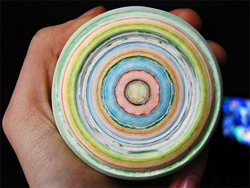Question: I would like to use visualization and law of attraction principles with my tapping. How can I do that?
[NOTE: I have a feeling this article is going to ruffle a few feathers. The science cited is far from definitive, but very interesting. I would love your feedback on this so please let me know your thoughts.]
The tool that is cited the most in the LOA community is visualization. “If you can see it, you can be it.”
Personally, I have always been a little skeptical. I fall much more in line with what Tony Robbins is credited with as saying about visualization: “If you sit all day in your living room thinking about what you want, something will show up. It will be the repo man!”
In my mind visualization alone has never been enough. If it were every teenage boy would be dating a Playboy bunny (something they spend a great deal of time visualizing very emotionally).
Action is required.
The Science Of Visualization
One of the reasons I love science so much is because the attitude is, “You think this is true? Great! Let's test it to see if it really is so.”
To that end, a number of scientists have been putting visualization to the test. Four of these studies were featured at Forbes.com and what they found was that visualization in terms of just seeing what you want, actually makes it less likely for you to get what you want.
As the article states:
During the course of four experiments, Kappes and Oettingen demonstrated that conjuring positive fantasies of success drains the energy out of ambition. When we imagine having reached what we want, our brains fall for the trick. Instead of mustering more energy to get “there”, we inadvertently trigger a relaxation response that mimics how we would feel if we’d actually reached the goal. Physiologically, we slide into our comfy shoes; blood pressure lowers, heart rate decreases, all is well in the success world of our mind’s making.
The research also uncovers that the more pressing the need to succeed, the more deflating positive visualization becomes. One of the experiments tested whether water-deprived participants would experience an energy drain from visualizing a glass of icy cold water (a simple but elegant study design) and found that indeed, in even something so basic, the brain responds as if the goal has been reached.
From a “proof is in the pudding” standpoint, the research showed that participants told to visualize attaining goals throughout the course of the week ended up attaining far fewer goals than a control group told they could mull over the week’s challenges any way they liked. The positive visualizers also self-reported feeling less energetic than the control group, and physiological tests supported their claim.
That is a “WOW!”
Does That Mean We Stop Using Visualization?
In a word “No”!
What these studies point out is that just being in the moment and feeling what we want can be a harmful tool. It makes us feel better in the moment but it makes us less likely to take action.
But this not the only way to visualize. There are actually ways to use visualization that are very helpful. The key to using any tool is to ascertain how it can be useful in removing the things that are holding us back from taking action, and how it opens us up to opportunities to lead us to our goals.
There is a very simple way to do this and tapping will super-charge it.
Four Step Visualization Process Combined With Tapping That Works
There are a few things to keep in mind when looking at these four steps.
First, you don't have to do them in the order they are presented and you don't have to do all four steps in any one tapping session. As you will see each of these steps is set up to clear out different blocks to action. Clearing just one area is going to move you to a place where taking action is even easier.
Second, when doing each of these steps tap, tap, and then tap some more. Tap six or seven times on each point and then move to the next point. As you do each of the steps you are going to be tuning into the limiting beliefs and emotions that need to be tapped on. If we are tapping whilst these are surfacing we will clear them.
Third, for this to work you are going to need a clear vision of what you want and why you want it. There are many ways to write goals. I have a way that I think works best, but it is not the only way. Choose the way that makes the most sense for you.
Fourth, depending on the goal not every step is going to bring up every emotion and belief listed below. The ones that need to surface are the ones that will surface.
Step 1: Imagine Someone Else Achieving The Goal You Want
Task: In your mind imagine what it is like to witness someone else living the goal that you want to achieve. Imagine what their daily life is like as they have this goal. Imagine how they feel, imagine what they achieve, imagine what they feel as they achieve, and imagine the obstacles they encounter (AND how they get past these).
Goal: Doing this type of visualization can surface three types of emotions in us.
First, any jealousy that we have towards the people have achieved what we want will surface. Often the best resources we have to getting to our goal are the people who have already achieved something similar. If we are jealous of them it will be hard for us to look at their success from a distance and learn from it or, if we have access to the person, be able ask them for information to help to get ourselves to the same place. Our jealousy will shut us out from many resources we could use to take the right action.
Second, any emotions of inadequacy that we feel about the goal will start to surface. Thoughts of “That is right for them, but I could never have that!” If we don't feel worthy or deserving of a goal then we will stop ourselves from taking the action that will lead us to achieving them.
Third, any negative beliefs we or others might have towards this type of success will surface. For example we could be doing this type of visualization around financial success. We might see someone who is very wealthy treating those around them with disdain and contempt. If we believe that rich people are mean then we will prevent ourselves from taking action to reach this goal because we don't want to end up behaving the same way.
Step 2: Imagine Yourself Living The Goal
Task: This is not the “feel good and happy” as you imagine you are doing this. We are not looking to have warm fuzzy feelings while doing this. We are also not courting negative feelings. Instead, we want to feel realistically what it is like to have this goal happening in our life. How does it feel? What is exciting, frustrating, overwhelming, and impossible? Pay attention to all the emotions that come up. (Remember you are tapping while you do this.)
Goal: By realistically feeling (both good and bad) what comes along with the goal we will find our way to feelings of inadequacy, unworthiness, and overwhelm. We also might find emotions of “if we succeed we can lose it”. It is very hard for us to take action when we don't think we are worthy of the goal. By tapping on these emotions we are removing the block of thinking that it is impossible, making action more possible.
Step 3: Imagine You Know How Others Feel About Your Success
Task: This step is exactly like step two, but in step three we are going to add everyone else in our lives. As you see yourself living the goal also imagine that you can read the minds and hear the whispers of others as you enjoy success. Are they supportive, jealous, or saying how much you have changed? Are they feeling sad about their own lives or overwhelmed because your success is pointing out their failure? Obviously you have no idea what others are thinking, but just make a guess.
Goal: There are times where we will hold ourselves back because of what others might think about us.. I once had a client report “I know how my fat friends talk about my skinny friends. If I lose weight they will say the same horrible catty things about me.” If we think our success is going to hurt our relationships or how people see us in negative ways, then we will prevent our own success.
By imagining what others are saying and thinking about our success we are going to be able to name (and clear) the blocks that are holding back our action.
Step 4: Imagine Encountering Obstacles
Task: Imagine all possible roadblocks and obstacles to you achieving your goal. Imagine the things you don't know how to do. Imagine the people you ask for help saying “no”. Imagine your plans not working out. Imagine having everything go to plan and still not have it work out.
How do you feel when you imagine these scenarios? Keep playing them out in your mind. Now that something hasn't worked out what is your next step or next plan of attack. Did that work? If not, in your imagination try something new.
Goal: One of the types of visualization that Kappes and Oettingen recommend from their research is to imagine that we are facing different obstacles and roadblocks. By doing this we have the opportunity to practice responding to things that didn't work out. Instead of falling in a heap on the floor because it didn't work out, we are training ourselves to respond to changes of plans. We are getting a chance to deal with the emotions of rejection and failure when the stakes are very low. So that when obstacles come up (and they are going to come up) we are going to be emotionally prepared to deal with them.
Take Action
The time is now. You need to do something. You can’t sit around imagining things and expect them to show up at your doorstep. You need to know what you want, know what is going to stop you, clear yourself emotionally, and TAKE ACTION! Otherwise you are just daydreaming. Take some time each day and work these steps and you will start moving towards your goals.
Let me know what you think of this in the comments below.
 What are some of the ways you have added or changed the basic tapping recipe? Click here to
What are some of the ways you have added or changed the basic tapping recipe? Click here to 










